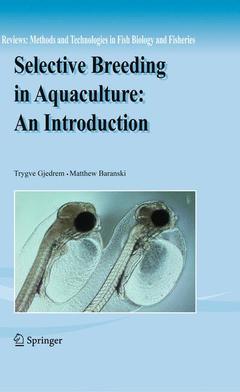Description
Selective Breeding in Aquaculture: an Introduction, 2009
Reviews: Methods and Technologies in Fish Biology and Fisheries Series, Vol. 10
Authors: Gjedrem Trygve, Baranski Matthew
Language: English
Subject for Selective Breeding in Aquaculture: an Introduction:
179.34 €
In Print (Delivery period: 15 days).
Add to cart
Selective Breeding in Aquaculture: an Introduction
Publication date: 03-2012
221 p. · 15.5x23.5 cm · Paperback
Publication date: 03-2012
221 p. · 15.5x23.5 cm · Paperback
179.34 €
Subject to availability at the publisher.
Add to cart
Selective breeding in aquaculture. An introduction (reviews : methods and tech nologies in fish biology and fisheries, vol. 10)
Publication date: 08-2009
Support: Print on demand
Publication date: 08-2009
Support: Print on demand
Description
/li>Contents
/li>Comment
/li>
The foundation of quantitative genetics theory was developed during the last century and facilitated many successful breeding programs for cultivated plants and t- restrial livestock. The results have been almost universally impressive, and today nearly all agricultural production utilises genetically improved seed and animals. The aquaculture industry can learn a great deal from these experiences, because the basic theory behind selective breeding is the same for all species. The ?rst published selection experiments in aquaculture started in 1920 s to improve disease resistance in ?sh, but it was not before the 1970 s that the ?rst family based breeding program was initiated for Atlantic salmon in Norway by AKVAFORSK. Unfortunately, the subsequent implementation of selective breeding on a wider scale in aquaculture has been slow, and despite the dramatic gains that have been demonstrated in a number of species, less than 10% of world aquaculture production is currently based on improved stocks. For the long-term sustainability of aquaculture production, there is an urgent need to develop and implement e- cient breeding programs for all species under commercial production. The ability for aquaculture to successfully meet the demands of an ever increasing human p- ulation, will rely on genetically improved stocks that utilise feed, water and land resources in an ef?cient way. Technological advances like genome sequences of aquaculture species, and advanced molecular methods means that there are new and exciting prospects for building on these well-established methods into the future.
Domestication and the Application of Genetic Improvement in Aquaculture.- The Success of Selective Breeding in Aquaculture.- The Theoretical Basis for Breeding and Selection.- Initiating Breeding Programs.- Breeding Strategies.- Selection Methods.- Mating Design.- Estimation of Breeding Values.- Genotype–Environment Interaction.- Measuring Response to Selection.- Structure of Breeding Programs.- Undesirable Side Effects in Breeding Programs.- Biotechnology in Breeding Programs.- Reproduction Techniques.- Economic Benefits of Breeding Programs.
An introductory guide to breeding programs in aquatic species A comprehensive description of the important concepts behind selective breeding in aquaculture
© 2024 LAVOISIER S.A.S.

